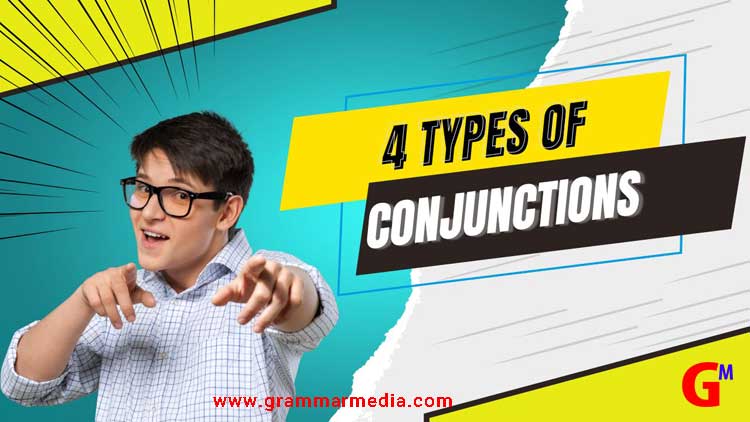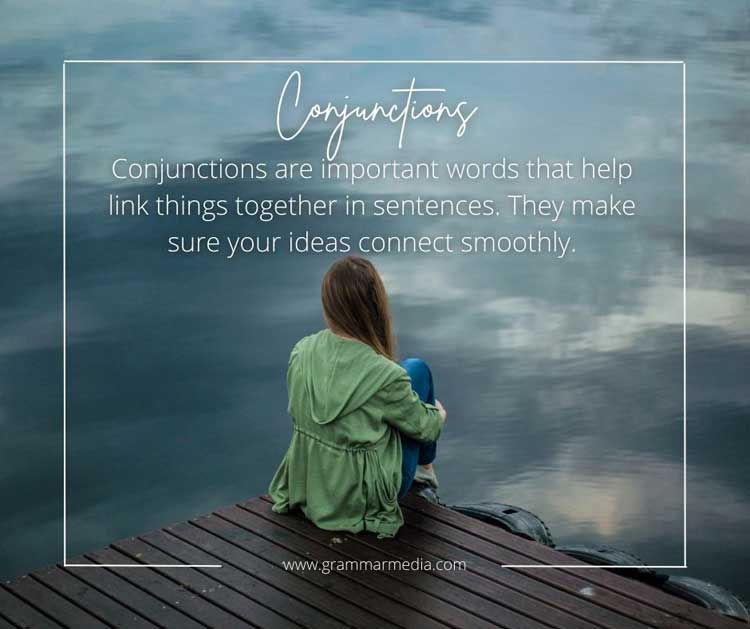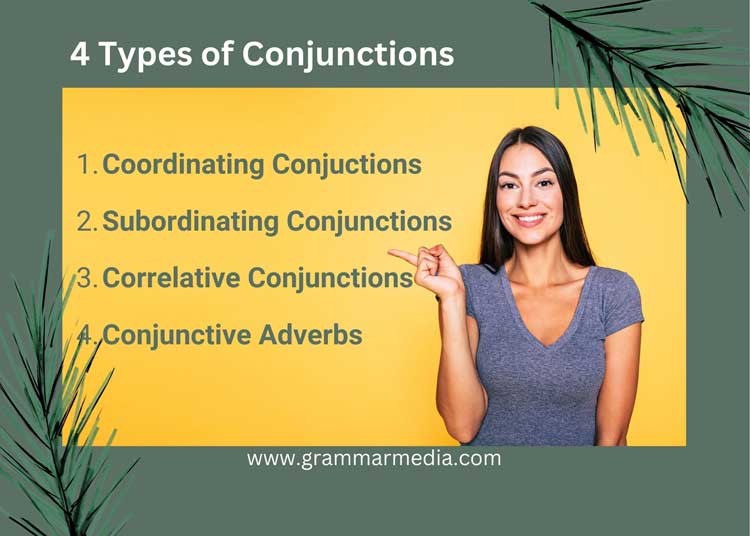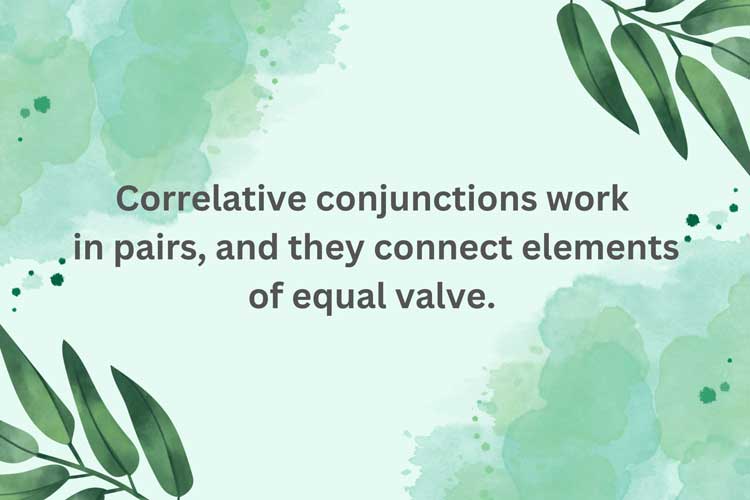Let’s talk about conjunctions—little words that aren’t super exciting, unlike nouns, adjectives, or verbs. But, guess what? They are really important for writing! Conjunctions help make writing smoother, connect ideas, and create fancy sentences.
If you understand how these little grammar helpers work, you can make your writing better and become a great writer. Let’s check out some examples of conjunctions, learn about the four types, and discover how to use them well to make your writing even better!
The 4 types of conjunctions are: coordinating conjunctions, subordinating conjunctions, correlative conjunctions, and conjunctive adverbs (or adverbial conjunctions).

What are Conjunctions?
Conjunctions are important words that help link things together in sentences. They make sure your ideas connect smoothly.
Conjunctions join words, phrases, or ideas together and they make your writing and talking sound better and more organized. There are different types of conjunctions and if you know how to use them, they will help you express your thoughts in a way that everyone can understand.

Some Examples of Conjunctions in Sentences
- Peter went to the markets, and he found a cheap camera. (coordinating conjunction)
- James didn’t go to work today because it rained. (subordinating conjunction)
- Paul gave his workers not only a bonus but also time off. (correlative conjunction)
- John worked long hours; otherwise, he would not have finished the project. (Conjunctive Adverb)
- Rachel went on a weekend holiday, so she could unwind from the stress at work. (coordinating conjunction)
- Terry hasn’t been able to go camping since the heavy rain. (subordinating conjunction)
- He is both over weight and unfit. (correlative conjunction)
- The police spotted the theives; however, they were unable to apprehend them. (conjunctive adverb)
What are the 4 Types of Conjunctions?
The 4 types of conjunctions are:
- Coordinating conjunctions (for, and, nor)
- Subordinating conjunctions (because, since, before>
- Correlative conjunctions (both/and, not only/but also)
- Conjunctive adverbs (however, therefore)

Let’s take a closer look at how to use the 4 types of conjunctions in sentences and what to look for in relation to punctuation and construction.
1. Coordinating Conjunctions
Definition: Coordinating conjunctions are single words that connect sentence elements with equal value like: nouns with nouns, verbs with verbs, phrases with phrases, or clauses with clauses.
Some Common Coordinating Conjunctions
- for
- and
- nor
- but
- or
- yet
- so
Examples of Coordinating Conjunctions:
- The police and army helped the victims of the tornado. (noun with noun)
- They cleaned and watered my garden while I was on holidays. (verb with verb)
- James loves researching problems and writing solutions on his blog. (phrase with phrase)
- Peter worked long hours during the week, so he could complete the project before the weekend. (clause with clause)
- The family went to the local show, which had trucks and tractors on display. (noun with noun)
- I got to school before Peter but after John. (phrase with phrase)
- David wrote and edited his blog post. (verb with verb)
- Timothy would prefer to practice at home but perform on the field. (clause with clause)
2. Subordinating Conjunctions
Definition: Subordinating conjunctions are one or more words that connect two clauses of unequal value. Subordinating conjunctions connect dependent clauses (incomplete thought) with independent clauses (a complete thought).
In other words, subordinating conjunctions are used to connect an independent or main (principal) clause with a dependent (subordinate) clause that relies on the main clause for meaning and relevance.
Some Common Subordinating Conjunctions:
- after
- because
- if
- that
- though
- although
- till
- before
- unless
- as
- since
- when
- where
- while
- than
- in order that
- as soon as
- in case
Examples of Subordinating Conjunctions:
- Unless I graduate from college, I will have wasted a lot of money.
- You will need to bring the speaker to the convention center as soon as he arrives.
- We waited for several hours till the President arrived.
- Because he was lazy, he was sacked from office.
- If you follow the rules, you will do well in this business.
- Before you take the test, you will need to know the information well.
- You will need to study well before you take the test.
- You will need to clean the venue after they celebrate Jonathan’s birthday.
NOTE: If the subordinating conjunction and dependent clause are at the beginning of the sentence, you will need to use a comma. If not, a comma is not required. See examples above.
FOR YOUR INFORMATION: Most grammarians suggest that subordinating conjunctions are divided into eight classes. They include time (before, after), reason (since, because), purpose (that, in order that), result (so, that), condition (if, unless), circumstance (seeing that), concession (although, though), and comparision (as, than).

3. Correlative Conjunctions
Definition: Correlative conjunctions work in pairs, and they connect elements of equal value.
In other words, correlative conjunctions get their name from the fact they work together (co-) and relate one sentence element to another. Therefore, they are regarded as team conjunctions because they work together in parallel in construction.
Some Common Correlative Conjunctions:
- either/or
- neither/nor
- both/and
- not only/but also
- whether/or
- such/that
- so/that
- scarcely/when
- as many/as
Some Examples of Correlative Conjunctions:
- Either you pay back the money, or I will go to the police.
- I had scarcely walked in the door when I got the devastating phone call about my mother’s death.
- Susan was not only mean but also rude.
- Both David and James are going to the game tonight.
- Not only did they damage the car in the accident, but also they were fined for speeding.
- Whether you like it or not, you will need to complete the assignment to graduate.
- Peter is both smart and creative.
- Brandon not only spoke well, but also his speech was very challenging.
FOR YOUR INFORMATION: “Correlative conjunctions are link words that consist of two parts and are used to give emphasis to the combinations of two structures that are balanced.” (A Quote from Sahebkeir & Aidinlou, p. 125)
4. Conjunctive Adverbs
Definition: Conjunctive adverbs are one or more words that connect independent clauses together, which are of equal value.
In other words, conjunctive adverbs function much like coordinating conjunctions in that both connect independent clauses. However, you can notice the difference in the sentence pattern of conjunctive adverbs because the conjunctive adverb is preceded by a semicolon and followed by a comma.
Some Common Conjunctive Adverbs:
- however
- nevertheless
- otherwise
- instead
- therefore
- indeed
Some Examples of Conjunctive Adverbs:
- Timothy apologized sincerely; however, the damage was already done.
- The builders finished the construction on time; however, there were some unresolved problems.
- The leadership meeting was canceled; therefore, I could spend the night with my family.
- The thunder storm was violent; consequently, many homes were destroyed.
- I have always been good at speaking in public; in contrast, my wife finds it very difficult.
- The wealthy retiree did not spend all his money on himself; instead, he gave much to charity.
- The team worked long hours; therefore, they deserved their bonus.
- The marathon was challenging; indeed, it tested our fitness and determination.
FOR YOUR INFORMATION: When conjunctive adverbs join two independent clauses in one sentence, it is preceded by a semicolon and followed by a comma. This sentence pattern helps identify conjunctive adverbs.